Choosing Tropical Hardwoods
Rain forest preservation finds an unlikely ally in small-scale cooperatives that harvest wood
Synopsis: Jason Grant, director of Good Wood Alliance and co-founder of EcoTimber, talks about buying tropical hardwoods with a clear conscience. According to Grant, woodworkers who want to do the right thing for rain forests should learn more about forest management practices for the exotic woods they currently use and start using lesser-known species that are abundant and come from sustainably managed sources. He talks about community-oriented forestry programs that are providing replacements for exotic woods and harvesting commercial species more sustainably. He also discusses certification and how that can make a difference.
Concern for the environment is a passion these days, and woodworkers have practical as well as philosophical reasons to care. Alarming stories of widespread timbe r ove rharvesting and tropical forest decline appear frequently in newspapers and on television. Already, some premier furnituremaking woods have been lost. Cuban mahogany (Swietenia mahagoni) lapsed into commercial extinction near the turn of the century, and Brazilian rosewood (Dalbergia nigra) has become so scarce that it is now banned from international trade. Others are threatened. Burmese teak (Tectona grandis) and Honduras mahogany (Swietenia macrophylld) are not as plentiful as they once were, and lumber quality has diminished. Even though both species are available at relatively reasonable prices, highly figured boards and dense, old-growth lumber are harder to come by. Unless more conservation steps are taken (see the photo at right), these popular exotics and others could suffer a fate similar to rosewood’s.
Woodworkers who want to do the right thing for rain forests can do two things to help: learn more about the forest management practices for the exotic woods they currently use (see the photo on the facing page), and start using lesser-known species that are abundant and come from sustainably managed sources.
What’s on the horizon for mahogany, other exotics?
In November 1994, delegates to the Convention on International Trade in Endangered Species narrowly defeated a proposal to add Honduras mahogany to a list of species that are potentially threatened by overharvesting. The outcome may be different next time.
Though it’s true that uncontrolled logging contributes to tropical deforestation, other factors are at work, such as agriculture, cattle grazing, fuel-wood gathering, oil drilling, mining and dam building.
One promising development is the recent proliferation of community-oriented forestry programs. They are making replacements for mahogany, teak and other exotic woods available, while they attempt to harvest commercial species more sustainably.
In southeastern Mexico, for example, community groups, backed by development agencies and the Mexican government, are attempting to bring more than a million acres under sustainable management. Honduras mahogany in that region grows among about 100 other tree species (most lacking commercial value at present).
From Fine Woodworking #118
For the full article, download the PDF below:
Fine Woodworking Recommended Products

DeWalt 735X Planer

AnchorSeal Log and Lumber End-Grain Sealer

Ridgid R4331 Planer






















Log in or create an account to post a comment.
Sign up Log in